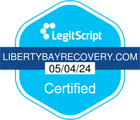Opiate Withdrawal Detox Program in Maine
Opiate addiction is the compulsive use of opioids, despite the dangers the drug poses to your body and mind.

Opiate Abuse, Addiction, and Detox in Maine
Opioids bind to dopamine receptors in the brain, causing euphoria, which can eventually lead to addiction. Opioid use and opioid overdoses continue to increase, and the year 2023 saw an overdose rate of 112,000 in a 12-month period.
Opiate detox centers provide the crucial support needed for individuals with severe or even mild addiction to opiates. Seeking professional help is the most effective path toward recovery.
The Importance of Professional Opiate Detox
Opiate detoxification can cause a number of withdrawal symptoms. However, the intensity of the withdrawal symptoms will depend on the user’s health, the severity of their addiction, and if they have other mental health disorders.
In general, individuals may experience the following withdrawal symptoms:
- Dehydration
- Increased blood pressure
- Flu-like symptoms
- Muscle aches
- Anxiety
- Irritability
- Insomnia
- Excessive sweating
Later, individuals may suffer from additional withdrawal symptoms, such as:
- Diarrhea
- Nausea
- Vomiting
- Abdominal cramping

The Dangers of Detoxing Alone
Because withdrawal symptoms from opiates can be intense, going through the detox phase alone can be dangerous. The discomfort is often so intolerable that people relapse just to alleviate the discomfort.
Worse, some withdrawal symptoms, such as diarrhea and vomiting, can result in electrolyte imbalances and other complications that may require medical attention. If people addicted to opiates are not supervised by medical professionals, the risk of their withdrawal symptoms becoming life-threatening increases dramatically.
Withdrawing from opiates can also lead to depression and suicidal thoughts. Without a medical team monitoring those in detox, users may be more inclined to relapse or attempt suicide.
What’s more, when you detox alone, you may not have access to medications that can help ease the withdrawal symptoms to promote a better recovery. In a 24/7 supervised detox facility, you’ll get medical supervision, a safe environment, and access to medications.
Why Medical Supervision During Detox Is Necessary
There are several reasons why detoxing with medical supervision is crucial.
Help with withdrawal symptoms:
Medical professionals can prescribe medications to alleviate intense withdrawal symptoms. Medications such as methadone can help with cravings and reduce symptoms like nausea.
Safety:
As your body tries to repair itself, you may experience dehydration, cardiovascular complications, and nutrition deficiencies. When you enter a detox facility, the medical staff will monitor your vital signs daily, ensuring you get enough nutrients to support your body as it goes through the detox process.
Psychological support:
The opiate detoxification process can be psychologically challenging. A professional staff can offer therapy and support if you experience depression, anxiety, irritability, and cravings.
Fewer chances of relapse:
When you have access to a medical staff 24/7, you are less likely to relapse during the detox stage. This daily support can make a huge difference.
Continuity of care:
Once you complete the detox stage, detox facilities usually provide continuity of care. This means you can transition into a treatment program that has been customized to your needs.
Opiate Detoxification Methods: Exploring Options
If you need to detox from opiates, available methods range from medically supervised detox programs to more holistic approaches, each tailored to the specific needs and severity of addiction. Understanding the different methods available can help you and your family make informed decisions about the most effective and comfortable approach to detoxification.

Tapering
Tapering is a gradual reduction. You reduce the amount of opioids you take over time until your body is no longer dependent on the drug. This gradual reduction allows the body to adjust to the decreasing amounts. Most tapering is performed under the supervision of healthcare professionals to prevent complications.
Ultra Rapid Detoxification
If you are looking to detox in days rather than weeks, ultra rapid detoxification is an option. In a hospital, a medical team will stop the opioid use while you’re under anesthesia.
Outpatient Detoxification
For people with a mild opiate use disorder, outpatient detoxification may be sufficient. This method allows you to detox at home without around-the-clock supervision.
Medical Detoxification
One of the safest ways to detox is with medical detoxification. During the detox stage, you are prescribed another drug, such as methadone, to take the edge off the withdrawal symptoms. Medical detoxification is performed only under the supervision of a medical staff. However, it offers quite a few benefits: It provides a supportive environment, is safe, and can help with cravings.
Holistic Detoxification
Holistic detoxification is designed to provide emotional and physical well-being during the detox stage. With this method, you undergo therapies, such as yoga, massage, or meditation classes. Typically, holistic detoxification is combined with other forms of detoxification, such as medical or outpatient detox.
Understanding Opiate Withdrawal Symptoms
Withdrawing from opiates can be challenging, especially if you suffer severe withdrawal symptoms. Here is a more in-depth look at the withdrawal symptoms you can expect to experience. Recognizing these symptoms is crucial to prepare for the detox process and ensure that appropriate medical support and interventions are in place to manage these symptoms safely and effectively.
Flu-like symptoms:
Many people experiencing opiate withdrawal symptoms will experience symptoms such as muscle aches, runny noses, and fatigue.
Abdominal cramping:
As the body attempts to adjust to the lack of opiates in the digestive system, there may be abdominal cramping.
Nausea and vomiting:
For people with a severe opiate use disorder, withdrawal symptoms may include nausea and vomiting. Persistent vomiting can result in severe dehydration.
Insomnia:
Difficulty falling asleep or staying asleep is another withdrawal symptom. This can worsen feelings of irritability and fatigue.
Anxiety:
As the body attempts to rebalance itself, individuals in detox may experience heightened anxiety as well as intense mood swings. It’s important for medical staff to supervise individuals who have suicidal thoughts.
Excessive sweating:
During detox, the body attempts to rid itself of all the opiate toxins. This results in excessive sweating, especially at night.
Higher blood pressure:
Withdrawing from opiates can cause higher blood pressure and an elevated heart rate. These changes must be monitored daily to avoid medical complications.
Cravings:
People typically experience intense cravings for their drug of choice during the detox phase and even afterward. These cravings can be difficult to resist unless you’re in a detox facility.
Dilated Pupils:
People withdrawing from opiates tend to have dilated pupils, especially if they had a severe addiction. They may also be sensitive to light.
Chills:
People withdrawing from opiates tend to have chills, as the body has trouble regulating its temperature. This passes after a week or so.
The Severity and Duration of Withdrawal
The severity of withdrawal from opiates varies from person to person. Some factors that affect this include the intensity of the person’s addiction, the type of opiate used, the amount used, and the overall physical health of the person. It’s important to note that the type of opiate can range from heroin, fentanyl, and oxycodone to codeine.
The timeline of withdrawal, on the other hand, tends to be relatively standard. Here is a general timeline:
First 8–12 hours
The first withdrawal symptoms will set in within hours after your last dose. These symptoms will include anxiety, irritability, and intense cravings.
1–3 Days
Withdrawal symptoms tend to peak within one to three days. This is when you will experience excessive sweating, nausea, abdominal cramping, diarrhea, vomiting, dilated pupils, and more.
3–7 Days
After the peak period has passed, the symptoms will be the same but less intense.
After 7 Days
Many of the physical symptoms will have diminished. However, psychological symptoms, such as depression, irritability, anxiety, and cravings will remain. These can last for weeks or even months.
Management Strategies to Alleviate Withdrawal Discomfort
There are a few effective management strategies that can help mitigate the discomfort caused by withdrawal. Some include:
Medication-Assisted Treatment (MAT):
As mentioned above, MAT is designed to alleviate withdrawal symptoms by replacing an addictive opiate with a less harmful drug. These drugs, such as methadone, can help stabilize you physically so that the withdrawal symptoms are more manageable.
Hydration and Nutrition:
Your medical team will keep you hydrated so that you don’t suffer from dehydration after experiencing vomiting, diarrhea, and sweating. They will also balance your electrolytes and prepare nutritious meals and snacks.
Holistic Approaches:
Holistic approaches can go a long way to make clients feel more comfortable. Warm showers, massages, and meditation can help with muscle aches, anxiety, depression, and irritability.
Emotional Support and Guidance:
A professional staff can provide therapy and encouragement to clients experiencing withdrawal symptoms. They can also provide guidance by creating a customized treatment plan.
Choosing the Right Opiate Detox Program
Choosing the right opiate detox program isn’t always easy, as you have some factors to consider. Ensuring that the program aligns with your specific needs can significantly impact the effectiveness of the detox process and the likelihood of a successful recovery.
Accreditation and Licensing
A high-quality detox facility must be accredited by organizations like the Commission on Accreditation of Rehabilitation Facilities (CARF) or The Joint Commission. The facility should also be licensed. Proper accreditation and licensing tell you that the facility follows the recommended practices in addiction treatment and meets high standards of care for its clients.
Evidence-Based Treatments
Evidence-based treatments have been proven to be effective when assisting those with substance use disorders (SUDs). When researching opiate detoxification programs, make sure you can transition into a treatment program that offers evidence-based treatments. These should include cognitive behavioral therapy (CBT) and medication-assisted treatment (MAT).
24/7 Monitoring and Supervision
People undergoing opiate detox must have 24/7 medical supervision by a professional medical team. This ensures that they can address any medical complications immediately.
Qualified Staff
The team’s experience is paramount. Look for professionals with years of experience helping people with opiate use disorders. An experienced and qualified staff also provides peace of mind to clients’ families.
Comfort
How comfortable is the facility? Detoxing from opiates can be a grueling experience, and having a comfortable environment to do it in makes it easier.
Continuum of Care
Try to find a detox and rehab center that will look out for you after your detox and treatment end. Recovery from addiction is a lifelong battle, and high-quality facilities typically offer support groups and aftercare.
Holistic Therapy
Comprehensive therapy is important for your physical, emotional, and mental well-being. Does the center offer holistic therapy like meditation, yoga, or art therapy? Find out what the center does to help its clients achieve stability in all areas of their lives.
Customized Care
Every individual has different needs in recovery. Ask questions about customized care. You may need to work or go to school, so the facility should be flexible to your needs. The customized treatment plan needs to be addressed during the initial assessment stage, even before the detox phase begins.
Cost and Insurance
It’s important to find a facility that accepts your insurance. If it does, will there be out-of-pocket costs? Some facilities have payment plans that can help you cover the cost of detox.
Benefits of Professional Opiate Detox
Professional settings offer structured support that can significantly reduce the risk of relapse and ensure that individuals receive the necessary care tailored to their recovery needs. These are the benefits of opiate detox in a professional setting.
Having a medical team supervise your detox 24/7 ensures that you will receive the proper medical care. The staff can also help you manage your withdrawal symptoms effectively and can step in if there any life-threatening complications develop.
If you detox at home, you may not have access to drugs, such as methadone, that can help alleviate your withdrawal symptoms. These drugs can reduce the risk of relapse and make the detox process easier.
Once you detox, a professional staff can help you transition into a tailored treatment plan that addresses your needs. You may also have a mental health disorder. A medical staff can diagnose your co-occurring disorder and treat it along with your addiction.
When you detox in a facility, you will be removed from an environment that isn’t particularly supportive. A professional detox facility will prioritize your detox needs, your physical health, and your emotional needs.
After you detox, you’ll receive professional supervision and daily monitoring. This structured environment can reduce the risk of relapsing. You’ll also transition immediately to a treatment program.
What to Expect During Opiate Detox
Opiate detox programs have specific stages. Understanding what each stage entails can help you and your support network prepare for the challenges and milestones of detox.

Assessment
Before the detox process begins, medical professionals will thoroughly evaluate your health, your addiction history, what substance you are addicted to, and whether or not there are any co-occurring mental health disorders, such as bipolar disorder. This assessment is useful in determining the best detox approach and the tailored treatment plan to follow.
The Detox Stage
Once you start the detox stage, you will be monitored 24/7 to ensure you are well-hydrated. The healthcare team will also provide you with nutritious meals and a comfortable environment. More importantly, the staff will monitor you and help you manage your withdrawal symptoms. They can also address medical complications should any arise. If you need medications to reduce cravings and alleviate your symptoms, they can prescribe medication.
Psychological Support
During the detox stage, individual therapy and counseling can help you cope with psychological withdrawal symptoms, such as depression, anxiety, and irritability.
Transition to Customized Treatment
Not everyone who signs up for detox will continue with the treatment plans. However, most facilities highly recommend continuing with a treatment plan. Treatment options include residential rehab, outpatient rehab, support groups, and more. By continuing with a treatment plan, you increase your chances of achieving long-term sobriety.
There are short-term, medium-term, and long-term detox programs. Here are the key differences.
A short-term opiate detox program lasts three to seven days. This program is designed for people with mild opiate use disorders (OUDs).
Medium-term opiate detox programs typically last one to two weeks. Clients usually get more medical and psychological support as their withdrawal symptoms tend to be more intense. Medium-term detox programs are designed for people with moderate to intense OUDs.
Long-term opiate detox programs last for two weeks or longer, depending on the client’s needs. These programs provide intense medical and psychological support, as they are designed for people with chronic relapse issues or severe OUDs. These programs may offer gradual tapering and other ways to help clients detox from opiates.
Aftercare and Continued Support
Once the detox phase is complete, there must be aftercare and continued support for clients to minimize relapse. Here is why these services are important.
Ongoing Support
Once individuals detox and finish rehab, they will face challenges once they return to their everyday lives. Being back amid their old triggers could lead to relapse. Aftercare services can provide skills to help individuals deal with these challenges. One of the ways rehab facilities can do this is by having clients continue with individual therapy.
Monitoring
Detox and rehab facilities should monitor their clients’ progress to ensure they maintain their sobriety. This ongoing monitoring can help individuals remain motivated.
Resources
Rehab facilities can point clients toward educational resources or support groups, such as Narcotics Anonymous (NA). Support groups provide a sense of community as well as peer support. They can be especially beneficial for individuals who feel isolated and lonely due to their substance use disorder.
Help With Co-Occurring Disorders
Many people who have an opiate use disorder have a co-occurring mental health disorder. A rehab facility can help clients get ongoing treatment for their mental health disorders, which can help them maintain their sobriety.

Resources for Maintaining Sobriety Post-Detox
Some resources that can help post-detox include:
Individual counseling, like cognitive behavioral therapy or dialectical behavior therapy
Empowering Recovery at Liberty Bay Recovery Center
Opiate detoxification is the first step that will allow you to reclaim control over your life. If you need opiate addiction treatment, Liberty Bay Recovery Center can help. We will give you a thorough assessment before your opiate detox. When you detox at our professional rehab facility, you will receive around-the-clock monitoring. This allows us to check your vital signs daily.
Take the first step to free yourself from your addiction, and reach out to our team at Liberty Bay Recovery Center. We can help you start your journey to a healthier you.
RESOURCES
Addiction Recovery Blog
August 3, 2025
Overdoses are a difficult but critical topic to discuss Every year families and communities lose...
July 9, 2025
Attending your first social event after choosing sobriety can feel overwhelming You might wonder how...
June 19, 2025
Addiction can significantly impact the entire family dynamic Roles shift routines change and relationships can...




